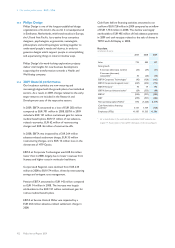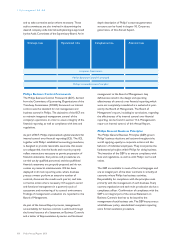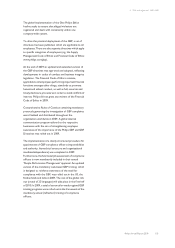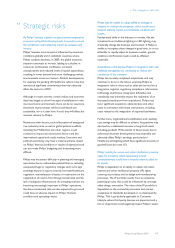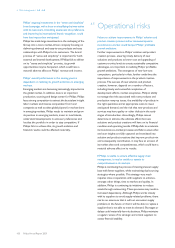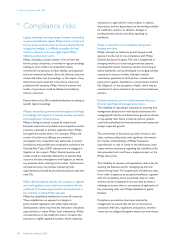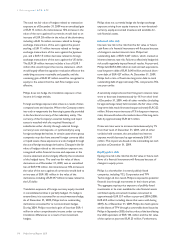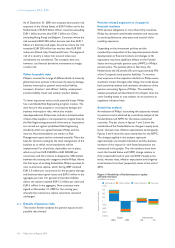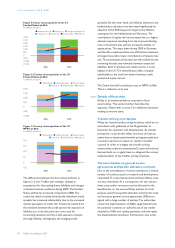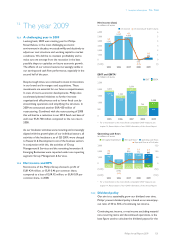Philips 2009 Annual Report Download - page 112
Download and view the complete annual report
Please find page 112 of the 2009 Philips annual report below. You can navigate through the pages in the report by either clicking on the pages listed below, or by using the keyword search tool below to find specific information within the annual report.Corporate Control, together with Sector and Functional
management, performs an assessment of financial
reporting risks at least annually.
For each risk identified a risk rating is assigned based on
the likelihood of occurrence and the potential impact of
the risk on the financial statements and related
disclosures. In determining the probability that a risk will
result in a misstatement of a more than inconsequential
amount or material nature, the following factors are
considered to be critical: complexity of the associated
accounting activity or transaction process, history of
accounting and reporting errors, likelihood of significant
(contingent) liabilities arising from activities, exposure to
losses, existence of related party transaction, volume of
activity and homogeneity of the individual transactions
processed and changes to the prior period in accounting
characteristics.
Important critical reporting risk areas identified within
Philips following the risk assessment are:
• Complex accounting for deferred tax liabilities, pension
benefits, and asset impairments
• Complex sales transactions regarding multi-element
deliveries (combination of goods and services)
• Past experience of control failures regarding
segregation of duties
• Significant (contingent) liabilities such as environmental
claims and other litigation
• Outsourcing of high volume/homogeneous
transactional finance operations to third-party service
providers.
Processes and controls related to the identified critical
risk areas will be subject to a more detailed set of
requirements regarding control documentation and
control evaluation (monitoring) by Sector and Functional
management due to their importance for the reliability of
the financial statements and disclosures of the Group.
Philips has defined-benefit pension plans in a number of
countries. The funded status and the cost of maintaining
these plans are influenced by financial market and
demographic developments, creating volatility in Philips’
financials.
The majority of employees in Europe and North America
are covered by defined-benefit pension plans. The
accounting for defined-benefit pension plans requires
management to determine discount rates, expected rates
of compensation and expected returns on plan assets.
Changes in these variables can have a significant impact on
the projected benefit obligations and net periodic pension
costs. A negative performance of the financial markets
could have a material impact on funding requirements and
net periodic pension costs and also affect the value of
certain financial assets and liabilities of the company.
For further analysis of pension-related exposure to
changes in financial markets, please refer to section 6.7.3,
Details of pension risks, of this Annual Report and for
quantitative and qualitative disclosure of pensions, please
refer to note 18.
Philips is exposed to a number of different fiscal
uncertainties which could have a significant impact on
local tax results.
Philips is exposed to a number of different tax
uncertainties which could result in double taxation,
penalties and interest payments. These include, amongst
others, transfer pricing uncertainties on internal cross-
border deliveries of goods and services, tax uncertainties
related to acquisitions and divestments, tax uncertainties
related to the use of tax credits and permanent
establishments, and tax uncertainties due to losses carried
forward and tax credits carried forward. Those
uncertainties may have a significant impact on local tax
results.
For further details, please refer to section 6.7.4, Details of
fiscal risks, of this Annual Report.
6.7.2 Details of treasury risks
Philips is, as mentioned before, exposed to several types
of financial risk. This section further analyzes financial
risks. Philips does not purchase or hold derivative financial
instruments for speculative purposes. Information
regarding financial instruments is included in note 32 and
note 33.
This section ‘Details of treasury risks’ up to and including
‘Other insurable risks’ forms an integral part of the Group
financial statements.
Liquidity risk
Liquidity risk is the risk that an entity will encounter
difficulty in meeting obligations associated with financial
liabilities.
The rating of the Company’s debt by major rating services
may improve or deteriorate. As a result, Philips’ future
borrowing capacity may be influenced and its financing
costs may fluctuate. Philips has various sources to mitigate
the liquidity risk for the group. As of December 31, 2009,
Philips had EUR 4,386 million in cash and cash equivalents,
a USD 2.5 billion Commercial Paper Program, and a USD
2.5 billion committed revolving facility that could serve as
back-up for short-term financing requirements that would
6 Risk management 6.7.1 - 6.7.2
112 Philips Annual Report 2009


